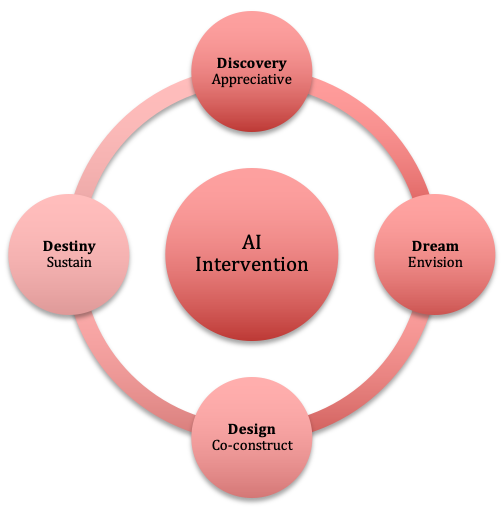The 4D approach in AI (Stavros and Cooperrider, 2003) refers to the four parts of the AI cycle
- Discovery: Identifying those moments in the past and present of the organization which are excellent, core values of the organization and the best practices;
- Dream: Envision positive possibilities for future success;
- Design: Cultivate and create the structure, processes and relationships required to support the dream;
- Destiny: Establish an action plan, which is both effective and inspirational.

The AI process
As a facilitator it is your job to set the environment to make open and honest dialogue possible. It is important to understand that there are particular norms, which are associated with an AI intervention, and must be clearly communicated to the participants. This includes starting and finishing the session on time, ensuring that there participants are clear that any and all questions are good questions, that in asking questions, especially during probing they must treat each other with respect. In addition to crafting questions to be positively framed, participants must give space to those being asked the question to answer it, fully. This means listening and giving people time to think before interjecting with the next question. Finally there is an acknowledgment that everyone is a teacher and a learner at the same time. No one has all the answers or THE answer, but we each hold a piece of the jigsaw.
Room set up
The furniture and setting of the room is important in regards to removing physical barriers. Ideally there will be no tables, and chairs will be seated in circle to demonstrate equality and encourage cross-communication. Since the process is participatory and people are learning from each other, it is important to provide room for movement within the room, and give space where the larger group can be split into pairs or small groups. The workshop itself is experiential so provision of craft materials, paper and pens with plenty of space to create is also essential.
Occasionally ideas will be surfaced which are good, but not within the scope of the topic being examined, provide a place for ideas to be parked which are important but need to be revisited either at the end of the AI workshop or outside of the workshop altogether.
A continuum of Participation
Pimbert and Pretty (1997) developed a continuum of participation to describe the different forms of participation, which can be experienced. AI seeks to develop participation, which is self-mobilizing, when agreeing an AI intervention it is important that the participants are empowered to implement the output of the AI workshop.

• Passive Participation – external stakeholders make the decisions and employees are told what is going to happen or has already happened.
• Participation by Information Giving – employees answer questions, giving information in response to requests from external stakeholders. However, the flow of information is one way and the employees but influence decision-making and information is not shared.
• Participation by Consultation – Employees are consulted, and external stakeholders are not obliged but may choose to take the interests of employees into consideration when developing solutions.
• Functional Participation – Employees are chosen by external stakeholders to participate in particular groups usually after major decisions have been made and with remits that are specified
• Interactive Participation – Employees participate in joint analysis and action planning, often taking control over regional issues within a wider set framework
• Self-Mobilization – employees are able to take the initiative and are independent of external institutions. They are empowered to change systems supported by external agents who may provide a facilitative role.













